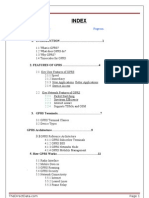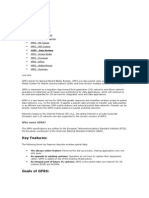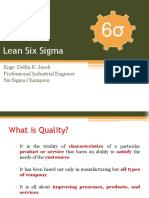GPRS 143
GPRS 143
Uploaded by
Engr. Naveed MazharCopyright:
Available Formats
GPRS 143
GPRS 143
Uploaded by
Engr. Naveed MazharOriginal Title
Copyright
Available Formats
Share this document
Did you find this document useful?
Is this content inappropriate?
Copyright:
Available Formats
GPRS 143
GPRS 143
Uploaded by
Engr. Naveed MazharCopyright:
Available Formats
Lab Assignment#5
CIIT(ATD)
ABBOTTABAD
GPRS (General Packet Radio Service)
Subject:
P.O.C.
Submitted By:
Naveed Mazhar FA09-BEE-143
Submitted To:
Sir Yousaf Murtaza Rind Date: December 27, 2011
Lab Assignment#5
CIIT(ATD)
GPRS (General Packet Radio Service)
GPRS is a packet based communication service for mobile devices that allows data to be sent and received across a mobile telephone network. A few years ago, GSM was the most successful cellular technology, but the need for higher data rates compelled scientists for new developments to enable data to be transferred at much higher rates. The first system to make an impact on the market was GPRS. GPRS technology enabled much higher data transfer rates as compared to GSM. GPRS technology offers data services with data rates up to a maximum of 172.2kbps. And it facilitates with web browsing and other services requiring data transfer. Data could also be transferred using GSM technology but it has relatively very low speed (about 9.6kbps). Actually, GPRS is used for global level for data communication. Usually GPRS is defined by 2.5G because it leaded to 3G. One thing very important is that GPRS always works in parallel with GSM because GSM can transfer voice (and data) but GPRS transfers only data.
Why to use GPRS
GPRS is used due to a number of benefits: 1-Packet Switching: The key element of GPRS is that it uses packet switched data rather than circuit switched data, and this technique makes much more efficient use of the available capacity. In traditional techniques, a circuit was switched permanently to a particular user. While in packet switching, data is transferred in packets. This makes this technique more efficient. Using GPRS the overall capacity can be shared between several users. To achieve this, the data is split into packets and tags inserted into the packet to provide the destination address. Packets from several sources can then be transmitted over the link. As it is unlikely that the data burst for different users will occur all at the same time, by sharing the overall resource in this fashion, the channel, or combined channels can be used far more efficiently. This approach is known as packet switching, and it is at the core of many cellular data systems, and in this case GPRS. 2- Always ON connectivity: GPRS works like a simple computer, which can be ON at any time when we want. In circuit switching one is billed for the time for which he has connected to internet (or called on mobile). But in this technique charges are on the basis of total data transferred. So, it offers Always ON services. This also attracts the user to use this packet switching technique.
Lab Assignment#5 3-High Speed:
CIIT(ATD)
As mentioned earlier GPRS has theoretically speed of 172.2 kbps, which is much more than the older mobile schemes like GSM which has about 9.6kbps. In real, 2050kbps is easily realizable 4-Low Cost: GPRS system has relatively very low cost as compared to the old used schemes. This is due to the use of packet switching instead of circuit switching. Also it is installed over GSM networks via software. Simply, its expenditure is very low.
GSM to GPRS
The figure below shows how a GSM system can be upgraded to offer GPRS services. This diagram shows that an existing GSM channel is removed, replaced, or upgraded to have GPRS and EDGE/EGPRS modulation and transmission capability. This diagram shows that packet control unit (PCU) must be added to the base station controller (BSC) and packet data switching nodes and gateways must also be added to allow data packets to be routed between mobile devices and data networks.
How GPRS Works
GPRS uses packet switching to transfer data from the mobile device to the network and back. The mobile device can begin sending packets immediately whenever it is used. By overlaying the GSM network, GPRS is able to take advantage of the world's leading digital phone system, with a global subscriber base of over 646.5 million and
Lab Assignment#5
CIIT(ATD)
growing (GSM Association, 01/02).It uses the same GSM radio frequencies and base stations that are already in place. GSM service is available in more than 150 countries and has become the de facto standard in Europe and Asia. It operates on the 900 and 1800 MHz frequency bands in Europe and Asia Pacific and 1900 MHz in North America. In the near future, North American operators will also begin using the 850 MHz frequency band for GSM/GPRS. GPRS improves on the data transmission capability of GSM while using the existing voice transmission capability. Users can have high quality voice conversations using circuit switched data up to 14.4 kbps and transfer data using packet switched GPRS at up to 53.6 kbps (85.6 kbps with advanced wireless networks).
GPRS Networks
GPRS is based on GSM communications and complements existing services such as circuit switched cellular phone connections and the Short Message Service (SMS). GPRS represents the bridge between 2G and 3G mobile telecommunications and is commonly referred to as 2.5G. GPRS implementation requires modification of existing GSM networks, because GSM is a circuit switched technology while GPRS is packet oriented. GPRS enables packet data (the same as is used by an Ethernet LAN, WAN or the Internet) to be sent to and from a mobile station for example mobile phone or Laptop. WAP and SMS can also be sent using GPRS and individuals working with GPRS need to learn and understand how the mobile stations, the air interface, network architecture, protocol structures and signaling procedures must be modified. GPRS offers much higher data rates than GSM and can be combined with 3G technologies such as EDGE (Enhanced Data-Rates for GSM Evolution) to give even higher bit-rates. It offers many benefits for customers and network operators: such as volume (rather then time) dependent billing and more efficient use of network resources. Due to the worldwide delay in implementing 3G solutions such as CDMA and UMTS the demand for GPRS is still growing. GPRS Networks 1-Offers detailed information ranging from standards to practical implementation 2-Answers 'how' and 'why' rather than just simply re-stating GPRS specifications 3-Provides comprehensive coverage in a single volume
GPRS Mobiles
It is not possible to upgrade an existing GSM mobile for use as a GPRS mobile, although GSM mobiles can be used for GSM speech on a network that also carries GPRS. To utilize GPRS new modes are required to enable it to transmit the data in the required format. With the incorporation of packet data into the network, this allowed far greater levels of functionality to be accessed by mobiles. As a result a new bread of started to appear. These PDA s were able to provide email and Internet browsing, and they were
Lab Assignment#5
CIIT(ATD)
widely used especially by businesses as they allowed their key people to remain in touch with the office at all times.
GPRS Mobile Classes
GPRS devices are not as straightforward. There are in fact 3 different classes of device. Class A: Class A terminals have 2 transceivers which allow them to send / receive data and voice at the same time. This class of device takes full advantage of GPRS and GSM. You can be taking a call and receiving data all at the same time. Class B: Class B devices can send / receive data or voice but not both at the same time. Generally if you are using GPRS and you receive a voice call you will get an option to answer the call or carry on. Class C: This device only allows one means of connectivity. An example would be a GPRS PCMCIA card in a laptop.
GPRS Data Communication
Some cooperation still exists between elements of the current GSM services and GPRS. On the physical layer, resources can be reused and some common signaling issues exist. In the same radio carrier, there can be time slots (TSs) reserved simultaneously for circuit-switched and GPRS use. The most optimum resource utilization is obtained through dynamic sharing between circuit-switched and GPRS channels. During the establishment of a circuit-switched call, there is enough time to preempt the GPRS resources for circuit-switched calls that have higher priority.
GPRS Service:
The GPRS provides a bearer service from the edge of a data network to a GPRS MS. The GPRS protocol layering is illustrated in Figure. The physical radio interface consists of a flexible number of TDMA time slots (from 1 to 8) and thus provides a theoretical raw data rate of 172.2 kbps. A Media Access Control (MAC) utilizes the resources of the physical radio interface and provides a service to the GPRS Logical Link Control (LLC) protocol between the MS and the serving GSN (SGSN). LLC is a modification of a High-Level Data Link Control (HDLC)-based Radio Link Protocol (RLP) with variable frame size.
Lab Assignment#5
CIIT(ATD)
The two most important features offered by LLC are the support of point-to-multipoint addressing and the control of data frame retransmission. From the standpoint of the application, GPRS provides a standard interface for the network layer.
Data Routing:
One of the main issues in the GPRS network is the routing of data packets to/from a mobile user. The issue can be divided into following two areas: 1-Data Packet Routing: The main functions of the GGSN involve interaction with the external data network. The GGSN updates the location directory using routing information supplied by the SGSNs about the location of a MS and routes the external data network protocol packet encapsulated over the GPRS backbone to the SGSN currently serving the MS. It also decapsulates and forwards external data network packets to the appropriate data network and collect charging data that is forwarded to a charging gateway. In Figure, three different routing schemes are illustrated: mobile-originated message (path 1), network-initiated message when the MS is in its home network (path 2), and networkinitiated message when the MS has roamed to another GPRS operator s network (path 3). In these examples, the operator s GPRS network consists of multiple GSNs (with a gateway and serving functionality) and an intra-operator backbone network. GPRS operators will allow roaming through an inter-operator backbone network. The GPRS operators connect to the inter-operator network via a boarder gateway (BG), which can provide the necessary inter-working and routing protocols (for example, Border Gateway Protocol [BGP]). It is also foreseeable that GPRS operators will implement QoS mechanisms over the inter-operator network to ensure service-level agreements (SLAs). The main benefits of the architecture are its flexibility, scalability, interoperability, and roaming.
Lab Assignment#5
CIIT(ATD)
The GPRS network encapsulates all data network protocols into its own encapsulation protocol, called the GPRS Tunneling Protocol (GTP), as shown in Figure. This is done to ensure security in the backbone network and to simplify the routing mechanism and the delivery of data over the GPRS network.
2-GPRS Mobility Management: The operation of the GPRS is partly independent of the GSM network. However, some procedures share the network elements with current GSM functions to increase
Lab Assignment#5
CIIT(ATD)
efficiency and to make optimum use of free GSM resources (such as unallocated time slots). (See Figure)
An MS has three states in the GPRS system: idle, standby, and active. The threestate model represents the nature of packet radio relative to the GSM two-state model (idle or active). Data is transmitted between aMS and the GPRS network only when the MS is in the active state. In the active state, the SGSN knows the cell location of the MS. However, in the standby state, the location of the MS is known only as to which routing area it is in. (The routing area can consist of one or more cells within a GSM location area.) When the SGSN sends a packet to a MS that is in the standby state, the MS must be paged. Because the SGSN knows the routing area in which the MS is located, a packet paging message is sent to that routing area. After receiving the packet paging message, the MS gives its cell location to the SGSN to establish the active state. Packet transmission to an active MS is initiated by packet paging to notify the MS of an incoming data packet. The data transmission proceeds immediately after packet paging through the channel indicated by the paging message. The purpose of the packet paging message is to simplify the process of receiving packets. The MS has to listen to only the packet paging messages, instead of all the data packets in the downlink channels, reducing battery use significantly. When an MS has a packet to be transmitted, access to the uplink channel is needed. The uplink channel is shared by a number of MSs, and its use is allocated by a BSS. The MS requests use of the channel in a packet random access message. The transmission of the packet random access message follows Slotted Aloha procedures. The BSS allocates an unused channel to the MS and sends a packet access grant message in reply to the packet random access message. The description of the channel (one or multiple time slots) is included in the packet access grant message. The data is transmitted on the reserved channels. The main reasons for the standby state are to reduce the load in the GPRS network caused by cell-based routing update messages and to conserve the MS battery. When a MS is in the standby state, there is no need to inform the SGSN of every cell change only of every routing area change. The operator can define the size of the routing area and, in this way, adjust the number of routing update messages. In the idle state, the MS does not have a logical GPRS context activated or any Packet-Switched Public Data Network (PSPDN) addresses allocated. In this state, the MS can receive only those multicast messages that can be received by any GPRS MS. Because the GPRS network infrastructure does not know the location of the MS, it is not possible to send messages to the MS from external data networks. A cell-based routing update procedure is invoked when an active MS enters a new cell. In this case, the MS sends a short message
Lab Assignment#5
CIIT(ATD)
containing information about its move (the message contains the identity of the MS and its new location) through GPRS channels to its current SGSN. This procedure is used only when the MS is in the active state. When an MS in an active or a standby state moves from one routing area to another in the service area of one SGSN, it must again perform a routing update. The routing area information in the SGSN is updated and the success of the procedure is indicated in the response message. The inter-SGSN routing update is the most complicated of the three routing updates. In this case, the MS changes from one SGSN area to another and it must establish a new connection to a new SGSN. This means creating a new logical link context between the MS and the new SGSN, as well as informing the GGSN about the new location of the MS.
Limitations of GPRS
Like all technologies GPRS also has some following limitations: Limited Cell Capacity: There are limited radio resources and voice and GPRS both uses same network resources hence they impact the existing cell capacity. Speeds Much Lower In Reality: The total bandwidth is divided among different user. Hence a single user cannot get the transmission speed up to 172.1 kbps. Sub-optimal Modulation: GPRS is based on a modulation technique known as Gaussian minimum-shift keying (GMSK). EDGE is based on a new modulation scheme that allows a much higher bit rate across the air interface. Transit Delays: GPRS packets are sent in all different directions to reach the same destination. Hence, one or some of those packets lost or corrupted during the data transmission over the radio link. No Store And Forward: There is no storage mechanism incorporated into the GPRS standard as compare to SMS.
Parameters
Some important GPRS key parameters are given by:
Lab Assignment#5
10
CIIT(ATD)
Channel Bandwidth Modulation type Data handling Max data rate
200 kHz GMSK Packet data 172.2 kbps
Problems in GPRS
Although GPRS has many benefits there have been a few problems. 1- Connection speeds until the end of last year performed badly on some networks running at around 12Kbps, a far cry from the expected. This year however there do not seem to be as many problems, probably due to the fact that operators are improving due to trial and error. GPRS is after all a pretty new technology. 2- Another problem sometimes encountered is customer expectation. Many companies have applications running on a 10 megabyte LAN and expect the same performance from their GPRS devices. Although the connection speeds these days are pretty good it still is not as fast as ISDN or Local Area Networks. To a certain extent operators have themselves to blame for this, since in the past their marketing has tended to promote the speed aspects of 2.5 and 3G. Today, they are working hard to reduce expectation in this respect. 3- Earlier problems with things like mail servers not sending mail because of latency problems to GPRS devices have all been pretty much eradicated through optimization programs. People running Citrix Thin Client has also encountered problems with latency although a few Thin Client forums suggest that Citrix are addressing the issue. 4- Deployment on some networks has been slow. There still is a major UK network provider who does not offer the service. 5- GPRS roaming has not been implemented in many countries on a lot of networks as yet. This is where a user can use the GPRS service from any network operator. At the moment although your GSM mobile will work, GPRS may not work at all. Accesses by third party application providers are having a lot of difficulty obtaining an APN from providers to offer their own GPRS services. Excuse: Sir! Initially I tried to make this assignment myself. But I could not do so, because of
lack of time. So, I have copied about 80% from internet but I have read the whole document.
You might also like
- Electronics - Communication Engineering Topic: (Type The Company Address)Document34 pagesElectronics - Communication Engineering Topic: (Type The Company Address)Varun SainiNo ratings yet
- SPEED: Theoretical Maximum Speeds of Up To 171.2 Kilobits Per Second (KBPS)Document31 pagesSPEED: Theoretical Maximum Speeds of Up To 171.2 Kilobits Per Second (KBPS)Eng W EaNo ratings yet
- Need For A Wireless WAN SolutionDocument27 pagesNeed For A Wireless WAN Solutionపుష్ప ఎం ఎస్ డిNo ratings yet
- Agilent Testing GPRS SignallingDocument24 pagesAgilent Testing GPRS SignallingPrasant KumarNo ratings yet
- (Ebook) Understanding General Packet Radio Service (GPRS)Document32 pages(Ebook) Understanding General Packet Radio Service (GPRS)chrispeweNo ratings yet
- General Packet Radio ServicDocument38 pagesGeneral Packet Radio ServicAmitesh SinghNo ratings yet
- Sunny GprsDocument18 pagesSunny GprsSumit KumarNo ratings yet
- P Resented byDocument14 pagesP Resented bysekhar2014No ratings yet
- General Packet Radio ServiceDocument30 pagesGeneral Packet Radio ServicesamhithaupadhyaNo ratings yet
- SPEED: Theoretical Maximum Speeds of Up To 171.2 Kilobits Per Second (KBPS)Document32 pagesSPEED: Theoretical Maximum Speeds of Up To 171.2 Kilobits Per Second (KBPS)yuben josephNo ratings yet
- General Packet Radio Service (GPRS)Document8 pagesGeneral Packet Radio Service (GPRS)DeepakNo ratings yet
- WMN Pro NewDocument24 pagesWMN Pro Newnayan29703No ratings yet
- WNM Chapter 2 FDocument14 pagesWNM Chapter 2 Fnavteshdeore19No ratings yet
- Traffic Analysis and Design of Wireless IP Networks: (Aisah)Document32 pagesTraffic Analysis and Design of Wireless IP Networks: (Aisah)Basuki Rahmat HakimNo ratings yet
- Introduction To General Packet Radio Service (GPRS) : Key User Features of GPRSDocument8 pagesIntroduction To General Packet Radio Service (GPRS) : Key User Features of GPRSbikisahuNo ratings yet
- GPRS - User CountDocument6 pagesGPRS - User CountAlthaf HussainNo ratings yet
- Data Transfer TechnologiesDocument3 pagesData Transfer TechnologiesNikhil DharNo ratings yet
- Gprs ReportDocument25 pagesGprs ReportGR Techno SolutionsNo ratings yet
- General Packet Radio Service (GPRS)Document32 pagesGeneral Packet Radio Service (GPRS)divyeshchauhan014No ratings yet
- Index: SR - No Name Page NoDocument40 pagesIndex: SR - No Name Page NoRaufrmzNo ratings yet
- Wireless Access GprsDocument11 pagesWireless Access GprsSara AbNo ratings yet
- GPRSDocument32 pagesGPRSSHUBHAM RANKAWAT SVNITNo ratings yet
- General Packet Radio Service (GPRS) Is A: Services OfferedDocument5 pagesGeneral Packet Radio Service (GPRS) Is A: Services Offeredrenuka_ec694456No ratings yet
- Gprs Demystified: CommunicationsDocument2 pagesGprs Demystified: Communicationsbhuvi2312No ratings yet
- GPRS TutorialDocument25 pagesGPRS TutorialthankhiepNo ratings yet
- c655eGPRS 1Document61 pagesc655eGPRS 1Tushar SaxenaNo ratings yet
- Lovely Professional University: TopicDocument3 pagesLovely Professional University: Topicابهيشيك جاورNo ratings yet
- General Packet Radio ServicesDocument8 pagesGeneral Packet Radio ServicesronyiutNo ratings yet
- Presented To: Presented byDocument23 pagesPresented To: Presented byfazlurrahman86No ratings yet
- C C C C C CC C C C C CDocument50 pagesC C C C C CC C C C C Cankitahuja25No ratings yet
- GPRS (General Packet Radio System) : Key DataDocument3 pagesGPRS (General Packet Radio System) : Key Datahappy2013No ratings yet
- Lecture - 3 PDFDocument29 pagesLecture - 3 PDFLatera FekedeNo ratings yet
- AbstractDocument1 pageAbstractAkshay ChaudharyNo ratings yet
- Who Owns GPRS ?Document2 pagesWho Owns GPRS ?GandhiNo ratings yet
- General Packet Radio Service or GPRS Is A GSM Based Packet Switched TechnologyDocument3 pagesGeneral Packet Radio Service or GPRS Is A GSM Based Packet Switched Technologytushar009823No ratings yet
- EDGE: Enhanced Data Rates For GSM EvolutionDocument38 pagesEDGE: Enhanced Data Rates For GSM EvolutionShebin.A.Khalam100% (1)
- General Packet Radio Service (GPRS) Is A Packet Oriented Mobile Data Service On The 2GDocument6 pagesGeneral Packet Radio Service (GPRS) Is A Packet Oriented Mobile Data Service On The 2GSaurav NegiNo ratings yet
- How The Stuff Works in GPRSDocument12 pagesHow The Stuff Works in GPRSVinAy SoNiNo ratings yet
- Seminar Report On General Packet Radio Service (GPRS) : Course Title: Seminar Course No.: ECE 4204Document47 pagesSeminar Report On General Packet Radio Service (GPRS) : Course Title: Seminar Course No.: ECE 4204A.K.M.TOUHIDUR RAHMANNo ratings yet
- Key Features:: Who Owns GPRS?Document5 pagesKey Features:: Who Owns GPRS?arunsuresh2005No ratings yet
- Wireless Data CommunicationDocument13 pagesWireless Data CommunicationROBIN SHIRLEY FATCHNo ratings yet
- Application Note: GPRS Mobile Phones - An Overview For Test ProfessionalsDocument8 pagesApplication Note: GPRS Mobile Phones - An Overview For Test ProfessionalshuyKHTNNo ratings yet
- GprsDocument21 pagesGprsPhanishankarNo ratings yet
- Performance Evaluation For Integrated High Altitude Platforms-Terrestrial General Packet Radio Service SystemDocument6 pagesPerformance Evaluation For Integrated High Altitude Platforms-Terrestrial General Packet Radio Service SystemHabib MohammedNo ratings yet
- What Is GPRS ?: Main Features of GPRSDocument5 pagesWhat Is GPRS ?: Main Features of GPRSMayank BansalNo ratings yet
- Devasenapathi. A, Mohamed Siraj. B Theni Kammavar Sangam College of TechnologyDocument7 pagesDevasenapathi. A, Mohamed Siraj. B Theni Kammavar Sangam College of TechnologyJose DahlsonNo ratings yet
- What Is EDGE? - The Basics: Use of 8PSK Modulation: in Order To Achieve The Higher Data Rates WithinDocument10 pagesWhat Is EDGE? - The Basics: Use of 8PSK Modulation: in Order To Achieve The Higher Data Rates WithinkianooshNo ratings yet
- E5-E6 - Text - Chapter 11. CM TECHNOLOGY OVERVIEW 4G 5GDocument13 pagesE5-E6 - Text - Chapter 11. CM TECHNOLOGY OVERVIEW 4G 5Gsumit15sksNo ratings yet
- Mod1 SlideDocument22 pagesMod1 Slide2020ecpriyanshnigambNo ratings yet
- General Packet Radio Service (GPRS) Is ADocument8 pagesGeneral Packet Radio Service (GPRS) Is AAjay AryaNo ratings yet
- Presentation Topic: GPRS (General Packet Radio Service)Document26 pagesPresentation Topic: GPRS (General Packet Radio Service)Anonymous xsK0G4INo ratings yet
- General Packet Radio Service (GPRS)Document32 pagesGeneral Packet Radio Service (GPRS)Zatin GuptaNo ratings yet
- GPRS PDFDocument2 pagesGPRS PDFHari HaranNo ratings yet
- WMN Chapter 2Document23 pagesWMN Chapter 2Manasvi DevlekarNo ratings yet
- EdgeDocument2 pagesEdgehaniavulaNo ratings yet
- GPRS White PaperDocument18 pagesGPRS White Paperanon-728131100% (1)
- 1 - 2 Evolution - 2 - 5G - GPRSDocument14 pages1 - 2 Evolution - 2 - 5G - GPRSKOMBOLCHA DRYPORTTERMINALNo ratings yet
- Usha Rama College of Engineering and Technology, Telaprolu, Krishna. (A.P)Document16 pagesUsha Rama College of Engineering and Technology, Telaprolu, Krishna. (A.P)Krish ChaituthekingNo ratings yet
- A Secured Botnet Prevention Mechanism For HTTP Flooding Based DDoS AttackDocument5 pagesA Secured Botnet Prevention Mechanism For HTTP Flooding Based DDoS AttackEngr. Naveed MazharNo ratings yet
- 1 s2.0 S1059056022000685 MainDocument16 pages1 s2.0 S1059056022000685 MainEngr. Naveed MazharNo ratings yet
- State Space Equations - Pole Assignment by State Feedback - Observer DesignDocument27 pagesState Space Equations - Pole Assignment by State Feedback - Observer DesignEngr. Naveed MazharNo ratings yet
- Chap5a Stability Analysis - ELE353 - Spr21Document4 pagesChap5a Stability Analysis - ELE353 - Spr21Engr. Naveed MazharNo ratings yet
- Jamaneurology Diener 2023 RV 220007 1677854360.36406Document12 pagesJamaneurology Diener 2023 RV 220007 1677854360.36406Engr. Naveed Mazhar100% (1)
- CNN LSTMDocument5 pagesCNN LSTMEngr. Naveed Mazhar0% (1)
- ListDocument2 pagesListEngr. Naveed MazharNo ratings yet
- 5 PID Controller DesignDocument24 pages5 PID Controller DesignEngr. Naveed MazharNo ratings yet
- 6 Digital Controller DesignDocument23 pages6 Digital Controller DesignEngr. Naveed MazharNo ratings yet
- Wheel Slip Control For The Electric Vehicle With IDocument9 pagesWheel Slip Control For The Electric Vehicle With IEngr. Naveed MazharNo ratings yet
- EE 4313 Homework 02 - 2Document1 pageEE 4313 Homework 02 - 2Engr. Naveed MazharNo ratings yet
- Outdated Example For Previous Version of Supplied SchematicDocument2 pagesOutdated Example For Previous Version of Supplied SchematicEngr. Naveed MazharNo ratings yet
- Fault Tolerant Flight Control Using Sliding Modes and Subspace Identification-Based Predictive ControlDocument21 pagesFault Tolerant Flight Control Using Sliding Modes and Subspace Identification-Based Predictive ControlEngr. Naveed MazharNo ratings yet
- HW1Document4 pagesHW1Engr. Naveed MazharNo ratings yet
- Matlab: All All LongDocument5 pagesMatlab: All All LongEngr. Naveed MazharNo ratings yet
- Lec03 MotorControlDocument45 pagesLec03 MotorControlEngr. Naveed MazharNo ratings yet
- Drive Calculator - DCbaseDocument1 pageDrive Calculator - DCbaseEngr. Naveed MazharNo ratings yet
- For (0.1,0.2,0.4,0.6,0.8,1) The ARL Chart Is As FollowsDocument5 pagesFor (0.1,0.2,0.4,0.6,0.8,1) The ARL Chart Is As FollowsEngr. Naveed MazharNo ratings yet
- List of Designated Branches HBLDocument1 pageList of Designated Branches HBLEngr. Naveed MazharNo ratings yet
- ECE 106: Digital Computer LabDocument6 pagesECE 106: Digital Computer LabEngr. Naveed MazharNo ratings yet
- In This Report We Have Deal With Stability in Aircraft by Auto Control System and Also by Using Pilot Stick ControlDocument12 pagesIn This Report We Have Deal With Stability in Aircraft by Auto Control System and Also by Using Pilot Stick ControlEngr. Naveed MazharNo ratings yet
- TrussDocument4 pagesTrussRilaNo ratings yet
- Sato 8490se ManualDocument268 pagesSato 8490se ManualJonathan SantoroNo ratings yet
- Low Operating CostDocument7 pagesLow Operating Costdeepti_singh_ntlNo ratings yet
- Anti-Theft ImmobilizerDocument43 pagesAnti-Theft ImmobilizerNick PNo ratings yet
- Level 3 Hamsae InstituteDocument6 pagesLevel 3 Hamsae InstituteIvana ArleneNo ratings yet
- ACB MasterpactDocument72 pagesACB Masterpactbeckam8883% (6)
- Background: Project Proposal: IV Infusion Rate Controller IIDocument2 pagesBackground: Project Proposal: IV Infusion Rate Controller IIAbraham JyothimonNo ratings yet
- Phase Failure Relay: Specification FunctionDocument1 pagePhase Failure Relay: Specification Functionsandesh sawateNo ratings yet
- TCT2 - Breaker Trip Coil Tester & TimerDocument2 pagesTCT2 - Breaker Trip Coil Tester & Timermohamed tinoneNo ratings yet
- Bai Tap Luyen Nghe Tieng Anh Lop 7Document5 pagesBai Tap Luyen Nghe Tieng Anh Lop 7Mỳ Tôm Đang Ăn0% (1)
- 839 - Schedule For Supplementary Examinations, 2020 To Be Held in January, 2020 Updated Upto 21.12.2019 PDFDocument43 pages839 - Schedule For Supplementary Examinations, 2020 To Be Held in January, 2020 Updated Upto 21.12.2019 PDFSayak MitraNo ratings yet
- G04U01 Complete 20170824 CompressDocument6 pagesG04U01 Complete 20170824 CompressMax ChangNo ratings yet
- Os ReportDocument93 pagesOs ReportMinsha N PNo ratings yet
- Mobile OS SecurityDocument21 pagesMobile OS SecuritySuman AnandNo ratings yet
- D 5093 - 90 R97 - RduwotmtukveDocument9 pagesD 5093 - 90 R97 - RduwotmtukveAlejandro MuñozNo ratings yet
- Numerical Analysis of Cantilever and Anchored Sheet Pile WallsDocument112 pagesNumerical Analysis of Cantilever and Anchored Sheet Pile WallsUlissipo1955100% (4)
- PCAB List of Licensed Contractors For CFY 2019-2020 As of 03 Sep 2019 - WebDocument746 pagesPCAB List of Licensed Contractors For CFY 2019-2020 As of 03 Sep 2019 - WebSuzy CorbyNo ratings yet
- Rotoflex CouplingDocument4 pagesRotoflex Couplings_padu3003@yahoo.comNo ratings yet
- Common 1 For Detergent Powder and Cake and LiquidDocument6 pagesCommon 1 For Detergent Powder and Cake and LiquidTayyib Khan100% (1)
- Scramjet Problem OccurDocument49 pagesScramjet Problem OccursakthiNo ratings yet
- TCS Aspire - Chapter 4Document6 pagesTCS Aspire - Chapter 4himanshu_garg93No ratings yet
- Module 1 - Introduction On Lean Six SigmaDocument94 pagesModule 1 - Introduction On Lean Six SigmaTricia Alianna SungaNo ratings yet
- PP Transaction Codes - SAP Materials, Documents, Tutorials1Document8 pagesPP Transaction Codes - SAP Materials, Documents, Tutorials1atu1981No ratings yet
- UT332 Temperature Humidity MeterDocument3 pagesUT332 Temperature Humidity MeterFernando PintoNo ratings yet
- M4 ManualDocument20 pagesM4 Manualamit64007No ratings yet
- How To Prepare QuestionairsDocument22 pagesHow To Prepare QuestionairsMaha IbrahimNo ratings yet
- Pinout Renaul ClioDocument2 pagesPinout Renaul Cliodavidjona82% (56)
- Fityk ManualDocument47 pagesFityk Manualdeceneu2005No ratings yet
- 13.0 Word 2013 ExcercisesDocument5 pages13.0 Word 2013 ExcercisesFatjona SaliuNo ratings yet
- Lipa BatangasDocument9 pagesLipa BatangasJeanray GonzalesNo ratings yet














































































































